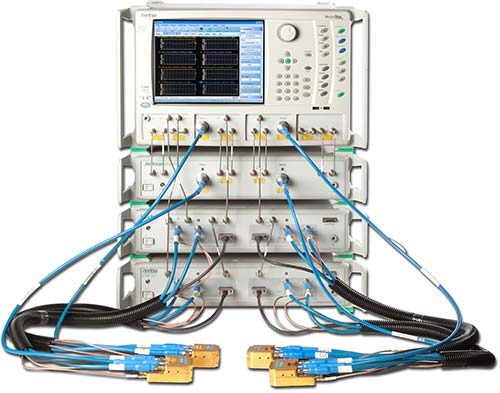 The fifth generation mobile network 5G is expanding into new industries as well as new technology areas because of the many benefits it offers in terms of positioning accuracy. Whereas 2G, 3G and 4G were mostly focused on consumer services such as voice, messaging and mobile browsing, 5G has been proving ideal for applications where connected devices need the level of accuracy or coverage that may not be available using global navigation satellite system (GNSS) positioning. These include autonomous vehicles, robots, Internet of Things (IoT) systems, indoor packaging, warehousing and ‘smart’ manufacturing facilities.
The fifth generation mobile network 5G is expanding into new industries as well as new technology areas because of the many benefits it offers in terms of positioning accuracy. Whereas 2G, 3G and 4G were mostly focused on consumer services such as voice, messaging and mobile browsing, 5G has been proving ideal for applications where connected devices need the level of accuracy or coverage that may not be available using global navigation satellite system (GNSS) positioning. These include autonomous vehicles, robots, Internet of Things (IoT) systems, indoor packaging, warehousing and ‘smart’ manufacturing facilities.
5G makes this possible by using precise positioning technology (PPT) through the third generation partnership project (3GPP) which encompasses telecommunications standards organisations around the world. While 3GPP specifications cover cellular telecommunications technologies, including radio access, core network and service capabilities, we can expect the PPT in ‘local 5G’ networks to be used for industrial applications. Designed to be the global standard for the air interface of 5G networks, 5G New Radio (NR) is a new radio access technology (RAT) developed by 3GPP for 5G applications.
The aim is to use 3GPP signalling in the 5G network to enhance the performance of position calculation. This involves using existing signals in the 5G network as well as introducing some specific new signals which directly support the enhanced positioning capability. The 5G positioning capabilities being introduced as 3GPP precise positioning features can supplement GNSS to enhance accuracy and/or improve measurement times. In addition, it can provide position information when GNSS is simply not available, such as indoor environments, factories, tunnels, underground car parks, ‘urban canyons’ and so on.
Among those looking at adopting 5G PPT are mobile network operators (MNOs), infrastructure vendors, chipset vendors, IoT module vendors, and the automotive and smart factory ecosystems mentioned earlier.
The feasibility of technical deployment
MNOs are currently in the process of estimating network deployment schedules and, although it can appear that MNOs follow the establishment of capability in the ecosystem, they are often the main driving force that creates demand within infrastructure vendors and device vendors. Once the capabilities are established within 3GPP specifications, and trials have proven the feasibility of technical deployment, the key issue for launch will be the business model suited to each industry segment.
Infrastructure vendors welcome the fact that no new physical entities are required with 5G PPT – which is built around new signalling capabilities in the radio access network (RAN) and new software functions in the core network – so feature development is typically software-based. The vendors are currently setting up demonstrators and trials to test and prove the new features before a widespread commercial launch. Once the 3GPP specifications are fixed for each release, network capability will be driven by the MNOs’ required time to market.
Chipset vendors have started to demonstrate the capability and ‘proof of concept’ for 5G PPT based on 3GPP Release 16 – which was released in July 2020 – and are engaging industry verticals with trials and evaluations. Again, as with infrastructure vendors, the features are mainly software driven. For RAN-supported features the chipset is mainly concerned with the measurement and reporting of the 5G NR position signals and measurements, with the focus on testing core functionality, standards compliance and basic performance in terms of location accuracy, time to fix and power consumption.
Complete module solution
 IoT module vendors have concentrated on integrating the cellular chipsets, GNSS functions and other sensor data into a complete module solution that can be deployed in single or multiple use cases. While the critical capability of 5G NR positioning is already provided by chipset vendors, IoT module vendors are looking more towards overall data integration and achieving the required performance levels and control interfaces to make the function useable and attractive to the various vertical industry sectors.
IoT module vendors have concentrated on integrating the cellular chipsets, GNSS functions and other sensor data into a complete module solution that can be deployed in single or multiple use cases. While the critical capability of 5G NR positioning is already provided by chipset vendors, IoT module vendors are looking more towards overall data integration and achieving the required performance levels and control interfaces to make the function useable and attractive to the various vertical industry sectors.
One vertical – the automotive sector – is currently evaluating 5G NR PPT to enhance the position accuracy in areas with poor GNSS coverage, with the aim of supporting autonomous driving and vehicle-to-everything (V2X) safety applications. Of course, autonomous driving use cases will require high position accuracy, for example to locate a vehicle in the centre of a designated lane, but in many scenarios GNSS can’t provide this. That’s why 5G NR is being evaluated as part of the overall sensor fusion capabilities to provide enhanced position accuracy as a supplement to GNSS.
The industrial smart factory sector also has a clear interest in 5G NR precise positioning, especially in terms of providing accurate positional information inside a plant or warehouse building where GNSS coverage may not be available. As the smart factory ecosystem currently evaluates the use of 5G NR for private 5G networks to provide wireless connectivity, it is a very attractive proposition to add precise positioning to this network capability.
‘Stand-alone’ positioning
 By operating as a ‘stand-alone’ positioning capability, 5G positioning will inherit many advantages of the 5G infrastructure that could potentially boost its accuracy. These include large cell site density which makes better positioning accuracy possible through many diversified anchor points being available for generating and processing positioning. Another advantage is the deployment of massive multiple input, multiple output (MIMO) and beamforming, which could enhance the direction accuracy for algorithms like Angle of Arrival (AoA) and Angle of Departure (AoD). The use of high-frequency channels by 5G networks could also contribute to better accuracy through reduced channel sparsity due to better array gains. Similarly, the large bandwidth provided by a 5G network could offer better multi-path resolution and, therefore, high accuracy for measuring distances, which again could contribute to improving the accuracy of positioning measurements. Finally, single infrastructure handling positioning and telecommunication functions will not only help in lowering the overall infrastructure cost but could open up the possibility of a number of new geo-information applications.
By operating as a ‘stand-alone’ positioning capability, 5G positioning will inherit many advantages of the 5G infrastructure that could potentially boost its accuracy. These include large cell site density which makes better positioning accuracy possible through many diversified anchor points being available for generating and processing positioning. Another advantage is the deployment of massive multiple input, multiple output (MIMO) and beamforming, which could enhance the direction accuracy for algorithms like Angle of Arrival (AoA) and Angle of Departure (AoD). The use of high-frequency channels by 5G networks could also contribute to better accuracy through reduced channel sparsity due to better array gains. Similarly, the large bandwidth provided by a 5G network could offer better multi-path resolution and, therefore, high accuracy for measuring distances, which again could contribute to improving the accuracy of positioning measurements. Finally, single infrastructure handling positioning and telecommunication functions will not only help in lowering the overall infrastructure cost but could open up the possibility of a number of new geo-information applications.
All these features will enable 5G positioning to create new opportunities in industrial asset tracking and commercial automation applications, essential in creating the Industrial IoT (IIoT) capability that will allow business owners to monitor and locate workers, assets and tools in real-time with a very high level of accuracy. Coupled with IIoT software platforms, these features should enable businesses to increase automation and enhance the efficiency of their factory processes.
A 2021 survey from ABI Research found that just over 50% of companies in five related industry verticals – healthcare, manufacturing, warehouse, transportation, oil & gas – planned to deploy real-time location services within the next five years, compared to a deployment rate at the time of just 13%.
Sidelink positioning
At the time of writing, 3GPP is studying and defining topics for expanded and improved positioning, particularly in terms of Sidelink positioning/ranging, improved accuracy, integrity, power efficiency and RedCap (reduced capability) positioning.
The automotive industry is especially interested in the Sidelink positioning feature because it can provide enhanced local information and positioning capability in scenarios where GNSS coverage isn’t available. The RedCap feature enables lower cost and lower specification devices and it is thought that the enhanced positioning capability provided by the 5G network can be of specific value for IoT applications.
 Several industry bodies in the automotive industry are working to provide requirements and technology for 5G PPT. Organisations such as SAE (an automotive industry group based in the USA) and 5GAA (car OEMs, network operators and related supply chains) provide inputs that create requirements for the development of 5G features in the 3GPP specifications. The industry activity also includes ETSI (European Technical Standards Institute), leading in the area of automotive ITS standards for Europe, and RTCM (Radio Technical Commission for Maritime Services), which provides US standards for differential GNSS systems where a supplementary signal from a known precise location is used to enhance GNSS positioning capability.
Several industry bodies in the automotive industry are working to provide requirements and technology for 5G PPT. Organisations such as SAE (an automotive industry group based in the USA) and 5GAA (car OEMs, network operators and related supply chains) provide inputs that create requirements for the development of 5G features in the 3GPP specifications. The industry activity also includes ETSI (European Technical Standards Institute), leading in the area of automotive ITS standards for Europe, and RTCM (Radio Technical Commission for Maritime Services), which provides US standards for differential GNSS systems where a supplementary signal from a known precise location is used to enhance GNSS positioning capability.
Expected reference signals
A vector signal analyser (such as the Anritsu MS2850A) can be used to capture the output of a 5G transmitter and display the contents of each frame or resource block. The specific resource elements relating to the expected reference signals can be checked for correct power level and format.
For user equipment (UE) measurements and reports, a network simulator (such as the Anritsu MT8000A Radio Communication Test Station) can be used to generate the downlink signal containing the relevant positioning reference signals with a known power level and position in the resource blocks. Control plane messages can then be configured and sent from the simulator to the UE to instruct it to make positioning measurements and report them back to the gNodeB (gNB) base station. The simulator will then receive the measurement reports from the UE and verify that the contents of the measurement report are correct and correspond to the downlink positioning reference signal conditions that were created. These conditions include power level, AWGN (additive white Gaussian noise) level and timing.
In addition to functional testing, the UE can be verified using protocol conformance test procedures. These are a standardised set of protocol message sequences that can verify the correct format and sequence for messages sent to and from the UE. There is also a set of conformance test procedures that can be used to verify the accuracy of the different measurement procedures.
‘Real life’ scenarios
There are other functional tests that are specified by various industry bodies, such as the Open Mobile Alliance (OMA) as well as MNOs, to simulate ‘real life’ scenarios for the system to provide accurate location information. These scenarios usually extend the scope of the UE testing to include further variations on GNSS signal conditions and network conditions to cover use cases beyond those of 3GPP conformance testing. This is usually done to cover scenarios and use cases which are specific to the MNO or to the specific network configuration they have chosen to deploy.
It’s clear then that 5G is ideal for applications where high accuracy levels are required and where its precise positioning technology is superior to anything offered through GNSS positioning. Over the coming years, a wider range of industries will find themselves benefiting from the many benefits of 5G PPT, resulting in substantial improvements in accuracy and efficiency.
Author: Jonathan Borrill
ANRITSU


